The Ten-Year Itch of a World Computer
Throughout the past century, humanity has repeatedly reimagined what a computer can be.
We’ve moved from the massive machines of the mid-20th century—built for rocket guidance—to IBM’s mainframes for business, to Microsoft and Apple making personal computers household staples, and finally to the era where smartphones put computing power into everyone’s pocket.
Each breakthrough in computational power has fundamentally redefined how people connect with the world.
In 2013, a 19-year-old Vitalik Buterin had a revelation while playing World of Warcraft: after Blizzard arbitrarily nerfed the warlock class, Vitalik began to seriously question—who, in the digital world, has the authority to change the rules at will?
What if there existed a “world computer,” one that wasn’t owned by any company or controlled by a single authority, but was open for everyone to use—could this become the next paradigm of computing?
On July 30, 2015, in a small Berlin office, dozens of young developers watched the blockchain counter. When it flipped to block 1,028,201, the Ethereum mainnet launched itself automatically.
As Vitalik later recalled, “We were all sitting there waiting, and then it finally reached the number. About half a minute later, blocks began to be produced.”
At that moment, the spark of the world computer was lit.
The Genesis and the First Spark
Back then, Ethereum had fewer than a hundred developers. For the first time, smart contracts were embedded in a blockchain, offering a Turing-complete platform and transforming the blockchain from a simple ledger into a global public computer that could run any program.
This new world computer quickly faced its first major test.
In June 2016, The DAO—a decentralized autonomous organization built on Ethereum—was hacked through a smart contract vulnerability, resulting in $50–60 million worth of ETH being stolen. The community fiercely debated whether to “reverse the blockchain.” Ultimately, a hard fork recovered the funds but split the chain, giving birth to Ethereum Classic.
This event brought governance issues into the spotlight: should the world computer remain immutable, or should it correct errors to protect users?
The ICO boom of 2017–2018 propelled Ethereum to new heights, with projects raising tens of billions of dollars via token sales on the platform and ETH prices soaring. But the subsequent bubble burst sent Ethereum into a slump: by the end of 2018, ETH had plunged more than 90% from its peak, with network congestion and high gas fees drawing sharp criticism. During this period, the CryptoKitties craze nearly brought the mainnet to a standstill, exposing for the first time the world computer’s limitations in processing capacity.
To overcome these bottlenecks, the Ethereum community began researching on-chain sharding solutions as early as 2015. They sought to boost throughput by splitting node validation workloads. Sharding proved technically challenging and progressed slowly, so developers also explored off-chain scaling strategies—from early state channels and Plasma to Rollups, which surged in popularity in 2019. Rollups significantly increased throughput by bundling large numbers of transactions and submitting them for mainnet verification, but they rely on the mainnet for robust data availability. By around 2019, Ethereum had made critical breakthroughs in data availability, solving the challenge of validating large-scale data.
These innovations enabled Ethereum to pursue a “mainnet security and layer 2 execution” scaling roadmap and begin breaking the world computer into a multi-layer collaborative system.
Over the following years, DeFi exploded on Ethereum—decentralized lending, trading, and derivatives flourished. The NFT boom thrust digital art into the limelight, with Beeple’s piece fetching $69 million at Christie’s. Even as activity soared, high gas fees persisted. But Ethereum’s protocol upgrades began to address the issue. In August 2021, EIP-1559 introduced a base fee burn that destroyed ETH with every transaction, reducing inflationary pressure during periods of high demand. For brief intervals during the 2021–2022 bull market, this reform made ETH net deflationary, driving its price to an all-time high near $4,900.
On September 15, 2022, The Merge transitioned the network’s core energy source from power-hungry PoW to PoS, slashing energy use by 99%, cutting new ETH issuance by 90%, and allowing holders to stake and help secure the network. The world computer’s energy system was completely transformed.
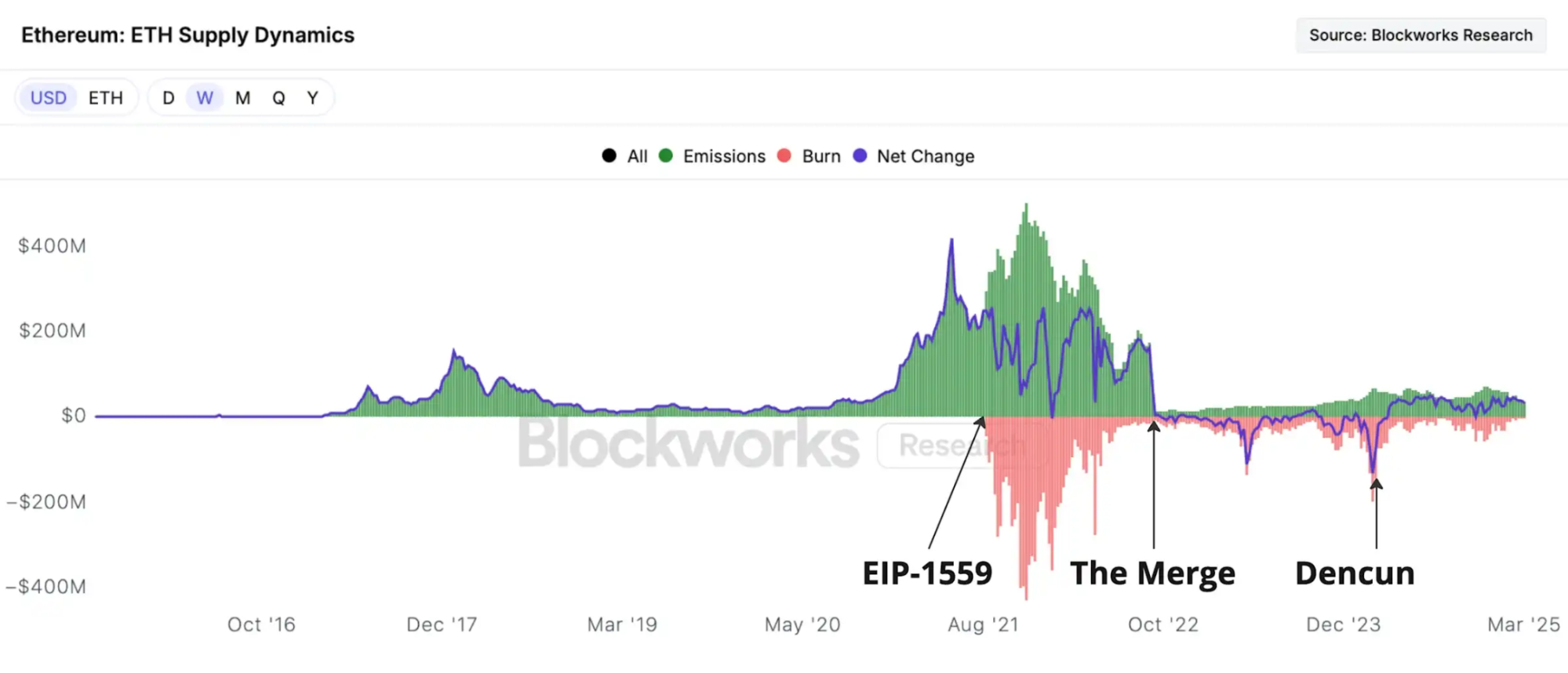
One year post-Merge, Ethereum’s net supply had shrunk by roughly 300,000 ETH—a striking reversal versus the inflation that would have occurred under PoW. This deflationary aspect has reinforced market expectations for ETH scarcity.
By the end of 2023, after these dramatic changes, Ethereum’s mainnet performance and economic mechanisms had both improved. Yet new challenges appeared. To reduce costs and fuel rollup growth, Ethereum implemented the “Dencun” upgrade (Deneb + Cancun) in March 2024, introducing EIP-4844, or Proto-Danksharding. This innovation allowed rollups to submit “data blob” transactions—short-lived, low-cost data storage for bundling layer 2 transaction data. The result: far cheaper fees for L2s to post data on the mainnet. The Dencun upgrade’s success marked a major drop in rollup costs, bringing the world computer another step closer to full sharding.
Ten years later, the world computer has evolved from a white paper concept to an irreplaceable piece of infrastructure for the digital economy.
Yet behind the glow of active nodes, new challenges are quietly emerging…
Midlife Uncertainties
Entering 2024–2025, Ethereum’s growing pains are now front and center.
Layer 2: Fragmentation Effects
Ethereum’s shift to a rollup-centric roadmap has eased mainnet congestion—but much of the activity and value remains on L2 networks, never returning to the main chain. Standard Chartered Bank’s early 2025 report bluntly stated that L2 growth is eroding mainnet value capture, estimating Coinbase’s Base L2 alone “removed” about $50 billion from Ethereum’s ecosystem market cap.
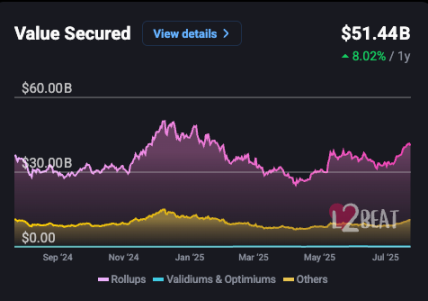
Transaction and application flow that once would have occurred on Ethereum’s mainnet has migrated to cheaper L2s, reducing mainnet fee revenue and on-chain activity. This trend intensified after the Dencun upgrade: EIP-4844 drastically cut costs for rollups to submit data to the base layer, further incentivizing L2 execution. In recent years, rollups like Arbitrum and Optimism have at times matched or even surpassed mainnet daily transactions, illustrating the reality of “outsourced execution” for Ethereum.
Put differently, the parts of the world computer are operating efficiently outside, while the mainnet’s capacity to capture value is being eroded.
Heightened Competition from External Blockchains
Ethereum’s past struggles with fees and throughput have opened the door for competitors offering speed and cost advantages.
Solana, designed for high throughput, has drawn a large developer base—most new projects and meme coins in this bull cycle have launched there. In stablecoins, Tron’s negligible fees have enabled it to support massive volumes of USDT issuance and transfers, with over 80 billion USDT now circulating on Tron—surpassing Ethereum and making Tron the world’s largest stablecoin network, with much higher turnover. This means Ethereum has ceded a critical segment of the industry.
BNB Smart Chain and other public blockchains have also grabbed market share in GameFi and altcoin trading. While Ethereum remains the leader in DeFi protocols and TVL (about 56% of the sector as of July 2025), it’s clear that Ethereum’s relative dominance has declined in today’s multi-chain world.
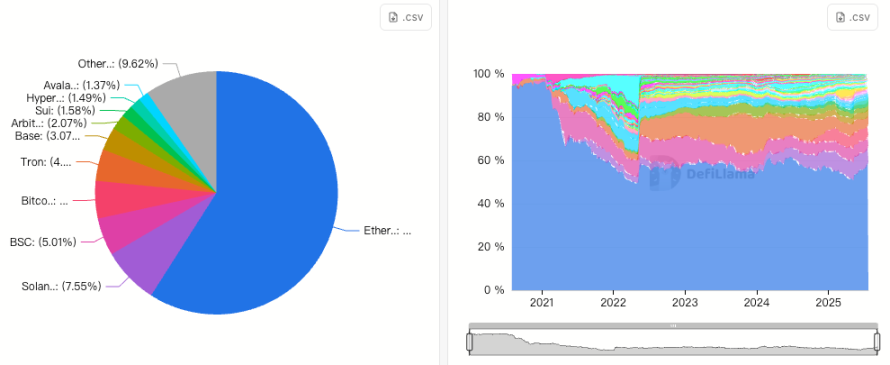
Governance and Security Concerns
The move to PoS has raised alarms about staking centralization. To participate as a validator, users need 32 ETH, pushing many to staking pools or centralized exchanges—enabling a handful of large players to dominate. The top decentralized staking pool, Lido, once held over 32% of the market. Although Lido’s share dropped to about 25% as new entrants arrived, it remains far ahead of Binance (8.3%) and Coinbase (6.9%). Community concern persists: if any single entity exceeds one-third of validator weight, it could threaten block consensus and network security.
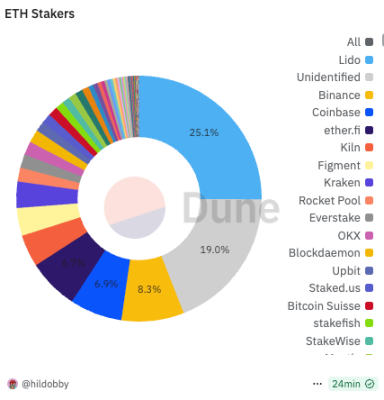
Vitalik has advocated for capping any validator entity’s share, suggesting it remain under 15% via fee mechanisms. Yet, in a 2022 Lido governance vote, a proposal to self-limit was rejected by over 99%. According to Dune Analytics, Ethereum now has over 1.12 million validators with more than 36.11 million ETH staked—roughly 29.17% of total supply. Balancing security with greater diversity among staking participants is still an open challenge.
The Foundation’s Controversial Role
The Ethereum Foundation’s lack of transparency in ecosystem funding and treasury management has been controversial for years. The community has often questioned high-point ETH sales without clear explanations, and some early developers believe the Foundation’s hands-off approach has fostered ecosystem fragmentation and confusion, hampering effective governance.
Meanwhile, leading voices such as Vitalik and other early developers, while remaining highly influential, have stepped back from making clear statements on key strategic issues—opting not to sway the market or intervene in governance debates. Over time, this restraint has created a vacuum: a lack of consensus, few taking responsibility for decisions, and little momentum for new proposals. Open discussion has declined, with strategic and technical decisions increasingly made behind closed doors.
Without a clear leader at the helm, the world computer continues to operate—but feels directionless.
Application Layer Gaps and Underwhelming Market Performance
If Ethereum aspires to be the world computer, its value must go beyond providing base-layer computation and security. Its greatest potential lies in hosting the next wave of innovative, mainstream applications that push the limits of what’s possible and attract new waves of developers and users.
Yet, after a decade, only DeFi and NFTs have achieved real, large-scale market validation. Beyond that, the application layer has largely fallen silent.
Promising categories—social, gaming, identity, DAOs—have yet to produce breakthrough, mainstream products on par with DeFi and NFTs.
Web3 social apps like Friend.tech and Lens had viral moments but quickly lost momentum due to poor retention; on-chain games generated buzz but mostly stalled at simple token-economy tests, struggling to reach the mainstream; decentralized identity and DAO governance remain limited to technical experimentation and niche pilots.
On-chain data confirms this gap. By July 2025, Ethereum’s daily ETH burn dipped below 50 per day, hitting record lows—a stark contrast to the 1,000+ daily ETH burns seen during the 2021 mania.

During the same period, the 7-day average for active addresses dropped to around 566,000, failing to surpass highs from March 2024; new daily addresses hovered around 120,000, and monthly on-chain transaction counts were in the 35–40 million range.
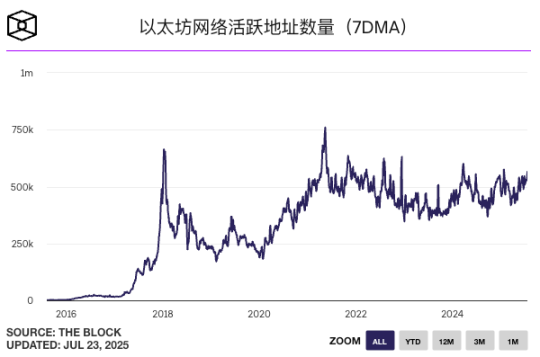
For a network that brands itself as the world computer, this signals a lack of the spark needed to kindle a new wave of mass-market apps.
Despite having the largest developer community in the industry and deep technical reserves, Ethereum still hasn’t found that “killer app” capable of bringing tens of millions of new users and transforming user habits. Ten years on, Ethereum remains robust—but is still searching for its next defining mission.
This stagnation is reflected in market performance as well. After nearly hitting $4,900 in November 2021, ETH hasn’t reached new highs in subsequent years. Even major upgrades like the Merge and fee reforms yielded only modest boosts. From 2022 through 2024, ETH’s price consistently lagged Bitcoin, Solana, and even BNB. In 2025, while other crypto assets hit new records, ETH hovered just over $3,000, with the ETH/BTC ratio dropping below 0.02 in April—a multi-year low. ETH, once considered the fuel for smart contract innovation, is losing its market edge as a wealth generator.
Recently, strategic allocations by public companies and institutions have offered some support for ETH prices. Firms such as Sharplink Gaming and BitMine have disclosed treasury strategies involving convertible bonds, preferred shares, or at-market offerings, channeling proceeds into ETH accumulation. Unlike Bitcoin, ETH can deliver returns generated by participating in staking and restaking protocols, making it an attractive “yield-bearing” digital asset for corporate treasuries. In a matter of weeks, ETH rebounded to over $3,600.
Yet some analysts argue that this rally is more about active capital deployment than organic growth in the on-chain ecosystem; the price jump is not being driven by innovation or surging user adoption, but rather by capital chasing short-term gains.
Technological progress and institutional entry alone won’t unlock the new applications needed to change user behaviors and spark fresh demand.
Ten years in, Ethereum still needs to answer the fundamental question: What applications must the world computer run to once again ignite global imagination?
The Road Unfinished: Charting the Next Decade
Facing the pressures of midlife, Ethereum’s ability to rebound rests on whether it can open up new frontiers through technological innovation and ecosystem growth.
Technology: A Faster, More Unified World Computer
The community has already outlined a post-Merge upgrade blueprint.
In his essay “Ethereum’s Possible Futures: The Surge,” Vitalik identifies the next phase’s core goal: increasing Ethereum’s combined (L1 + L2) throughput to 100,000 transactions per second, all while maintaining decentralization and L1 resilience. The aim is to ensure that key L2s retain core Ethereum values—trustlessness, openness, censorship resistance—and to unify the network’s user experience so that cross-L1/L2 transfers, fund movement, and app switching are as seamless as on a single chain.
EIP-4844, launched in 2024, is just the first step. Further improvements, such as data sampling and compression, are on the horizon.
As zero-knowledge proofs (ZK-SNARKs, ZK-STARKs) mature, performance bottlenecks could be eliminated, opening the door for users who previously migrated to other chains or L2s to return.
Governance & Economics: Restoring Mainnet Value
It’s not just about technical capacity—Ethereum is also exploring ways for its main chain to keep capturing value.
In July 2025, the Ethereum Foundation launched a sweeping reform called “The Future of Ecosystem Development,” aiming for greater leadership and guidance. The Foundation has set two long-term goals: 1) maximize the number of people who directly or indirectly use Ethereum and benefit from its core values, and 2) increase the resilience of both technical and social infrastructure.
To accomplish this, the Foundation has reorganized around four pillars—acceleration, amplification, support, and long-term enablement—set up new teams for enterprise relations, developer growth, application support, and founder support, and bolstered storytelling and content to strengthen community cohesion.
The Foundation also promises improved transparency, more targeted public goods funding, a Launchpad to support governance and sustainable operations, reduced operating expenses, and a budget buffer for roughly 2.5 years.
These moves are widely seen as the Foundation’s substantive response to “laissez-faire” criticism and as a critical investment for its next decade.
Community discussions are also exploring new approaches: can some of the L2 boom’s value be funneled back to the mainnet? Could tweaks to protocol fees or MEV sharing let the base layer share in rollup-era growth? Though still exploratory, these ideas reflect widespread concern—without adaptation, the mainnet risks becoming a pure settlement layer, with its value and vibrancy continually diluted.
At the Crossroads: Searching for the Next Spark
Technology and capital alone are not enough.
Each of Ethereum’s previous peaks was set off by new applications and narratives. Now, the entire blockchain industry is in a creative lull, lacking breakout phenomena.
The blockchain sector itself may need a self-reinvention, with new narratives and apps in social, identity, AI, and more. Some argue the next breakthrough may even come from outside the crypto ecosystem.
In his “Ethereum’s Next Decade” talk, Vitalik urged developers to look beyond copying Web2—to build for future interactions: wearables, AR, brain-computer interfaces, and local AI, all woven into Web3 design.
Looking back, Ethereum remains the industry’s largest developer community, has the richest application ecosystem, and deep technical reserves. But it now stands at a crossroads—facing both bottlenecks and new beginnings.
As Vitalik put it: “The past decade of Ethereum was spent on theory. In the next decade, we must focus on impact.” The next generation of apps must offer real utility and shared values—and be so easy to use that they draw in users who have never touched crypto before.
The world computer is experiencing a midlife crossroads. It hasn’t stopped running—just paused to find its new direction.
The next decade belongs to Ethereum—and to everyone who still believes in its dream.
As Vitalik also said, “Everyone who speaks up in the Ethereum community has a chance to help build our future together.”
Disclaimer:
- This article is republished from [Foresight News], with copyright belonging to the original author [ChandlerZ, Foresight News]. For republication concerns, please contact the Gate Learn Team, and our team will process your request according to established procedures.
- Disclaimer: The views and opinions expressed in this article are solely those of the author and do not constitute investment advice.
- Other language versions of this article are translated by the Gate Learn Team. Without proper reference to Gate, these translations may not be reproduced, distributed, or plagiarized.





